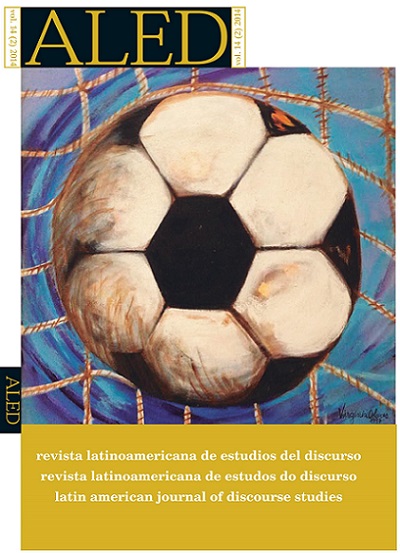El discurso del fútbol y los pathe
una aproximación lingüístico-cognitiva a las estrategias verbales afectivas
DOI:
https://doi.org/10.35956/v.14.n2.2014.p.7-22Keywords:
soccer. pathos. cognitive models. iconicity. interjections. metaphor.Abstract
This paper examines the role of pathos in the discourse of soccer as well as linguistic strategies employed, including interjections in moral or subjective means of persuasion, especially those belonging to the expressions of passion ”“pathÄ“”“ in contexts of the written press. Furthermore, we examine modalizers, subjectivemes, focalizations and metaphors resorting to affectivity and expressivity that orient the decodification process of the addressee. The notions of iconicity and cognitive models are taken from cognitive linguistics. We also use the concepts of subjective or moral evidence from Aristotle’s Rhetoric, as re-interpreted by Barthes (1997). The corpus consists of articles selected from the Argentinian sports daily Olé published between 2007 and 2014. From the analysis, we conclude that the strategies of Olé work towards creating its own soccer city.
Downloads
References
Alcaide Lara, E. 1996. Los operadores de modalidad. En C. Fuentes Rodríguez (ed.). Introducción teórica a la pragmática lingüística, pp.73-86. Sevilla: Facultad de Filología de Sevilla. Aristóteles 2002. Retórica. Madrid: Alianza.
Barthes, R. 1997. La aventura semiológica. Buenos Aires: Paidos.
Baudrillard, J. 1978. Cultura y simulacro. Barcelona: Kairós.
Bernardi, L. y Sáenz, C. 2008. [Disponible en www.redcomunicacion.org]. El lenguaje expresivo en los artículos de Olé: una estrategia frente al discurso audiovisual/virtual. En Memorias de las XII Jornadas de investigadores en comunicación, Red de Investigadores en Comunicación [Consulta: 15 marzo 2014].
Bernardi, L. y Sáenz, C. 2009. [Disponible en www.redcomunicacion.org]. Circuitos comunicativos de la prensa escrita en la era digital: cartas de lectores del diario Olé. En Memorias de las XIII Jornadas de investigadores en comunicación, Red de Investigadores en Comunicación [Consulta: 15 marzo 2014].
Bernardi, L. 2012. La interjección desde una perspectiva lingüístico-cognitiva. En G. Müller, L. Miñones y V. Barbeito (eds.). Estudios de lingüística cognitiva, pp.79-88. Mendoza: EDIUNC.
Cifuentes Honrubia, J. 1996. Gramática cognitiva. Fundamentos críticos. Madrid: Eudema.
Croft, W. 1990. Typology and universals. Cambridge: University Press.
Croft, W. y Cruse D. 2008. Lingüística cognitiva. Madrid: Ediciones AKAL.
Cucatto, A. 2009. [Disponible en www.fhuc.unl.edu.ar/]. La iconicidad en el lenguaje escrito. Un estudio lingüístico-cognitivo sobre la conectividad. En M. Arbusti y H. M. Manni (comp.) Actas del XI Congreso de la Sociedad Argentina de Lingüística (SAL), pp.1-10. Santa Fe: Universidad Nacional del Litoral. CD ROM.
Di Tullio, A. 2005. Manual de la gramática del español. Buenos Aires: La Isla de Luna.
Evans, V. y Green, M. 2006. Cognitive linguistics. An introduction. Edinburgh: University Press.
Frydenberg, J. 2011. Historia social del fútbol del amateurismo a la profesionalización. Buenos Aires: Siglo XXI.
Givón, T. 1990. Syntax: A functional-typological introduction, vol. 2, Amsterdam: Benjamins.
Kerbrat-Orecchioni, C. 1993. La enunciación. De la subjetividad en el lenguaje. Buenos Aires: Edicial.
Lakoff, G. 1987. Women, fire and dangerous things. Chicago: University Press.
Lakoff, G. y Johnson, M. 1995 [1980]. Metáforas de la vida cotidiana. Madrid: Cátedra.
Parret, H. 1986. Las pasiones. Ensayo sobre la puesta en discurso de la subjetividad. Buenos Aires: Edicial. Real Academia Española. [Disponible en: www.rae.es]. Diccionario de la lengua española. Vigésima segunda edición. [Consulta: 13 de noviembre de 2010; 14 de noviembre de 2010; 25 de marzo de 2012; 30 de octubre de 2012; 9 de mayo de 2013; 30 de mayo de 2014]. Sperber y Wilson. 1986. Relevance. Oxford: Blackwell.
Downloads
Published
How to Cite
Issue
Section
License

This work is licensed under a Creative Commons Attribution-NonCommercial-NoDerivatives 4.0 International License.
The authors retain the copyright and guarantee RALED the right to be the first publication of the work as well as a Creative Commons Attribution License that allows others to share the work with recognition of authorship and the initial publication in this journal.




